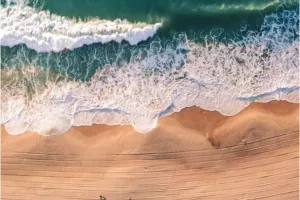Desert,mainly refers to the barren areas where the ground is completely covered by sand, the vegetation is very sparse, the rain is scarce, and the air is dry. Deserts are also called "sand curtains", which are areas of drought and water shortages and few plants. Desert areas are mostly sandy beaches or dunes, and rocks under the sand often appear. Some deserts are salt flats, completely devoid of vegetation. Deserts are generally aeolian landforms. There are sometimes valuable deposits in the desert, and many oil deposits have been discovered in recent times. Deserts have few inhabitants, and resource development is relatively easy.
1.Mirage
In the desert, because the sand and gravel are scorched by the sun during the day, the air near the sand layer rises very fast, forming a temperature distribution of the lower layer hot and the upper layer cold. At this time, the light of the scene in front will be refracted from the dense air to the less dense air, thus forming a lower mirage. From a distance, it looks like a reflection in the water. People who travel long distances in the desert, who are hot and thirsty, often mistakenly think that they have reached the cool lake when they see a mirage.
2.Gravel circle
After hundreds of years of thermal expansion and contraction of a large stone, it has been fragmented again and again and naturally weathered, and a circular gravel circle has been formed on the ground.
3.Mingsha
Singing sand, sand that makes noise. It is a natural phenomenon that exists in the world. The natural phenomenon of sand mingling is not only widely distributed in the world, but also the sound of sand is varied.
4.Wind Erosion Mushrooms
Wind-eroded mushrooms are first formed from wind-eroded columns. Wind erosion columns are mainly developed in the bedrock areas where vertical joints are developed. After long-term wind erosion, isolated columnar rocks are formed, so they are called wind erosion columns. It can stand alone or in groups. Due to the high sand content in the airflow near the surface, the abrasion is strong. If coupled with the difference in bedrock lithology, the wind erosion column is often eroded into a mushroom-like rock with a large top and a small base, which is called wind-eroded mushroom. The main reason for its formation is the erosion effect of wind. When the wind erosion is more serious, it will collapse.
Wind-eroded mushrooms are generally an epiphytic form of wind-eroded castles and other landforms developed in bedrock areas. It is easily distributed in the Yadan landform. Yadan landform is wind erosion landform, which refers to the surface shape formed by wind erosion and abrasion of surface materials, mainly formed by wind erosion and rain erosion. There are various landforms such as ridges, wind-eroded mushrooms, wind-eroded columns, wind-eroded ridges and grooves, wind-eroded depressions, residual hills, castles, etc. Yadan landform is named after the most typical wind-eroded landform in Yadan area near Lop Nur.
Are you curious about these bizarre phenomena in the desert?


